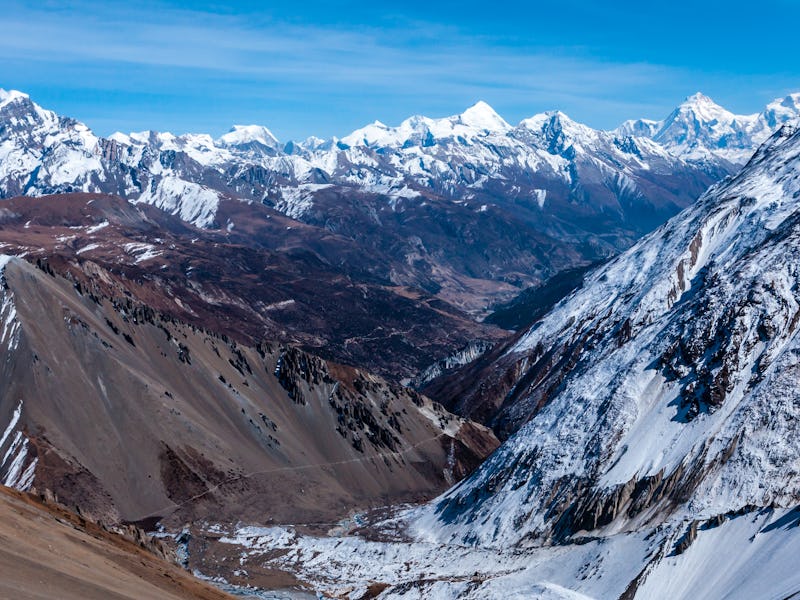Scientists find 240-year-old pollution from humans at ‘highest point on Earth’
The Himalaya's highest peaks have never been studied, but that doesn't mean they are untouched by humans.

In a disheartening new study, scientists reveal that long before humans made it to the pinnacle of Mount Everest, the mountain was already stained with the grimy fallout of human industrial activity.
Since the Industrial Revolution in Europe humans have produced machinery that’s leaked its influence into our environment — sometimes with drastic fallout. A new study reveals that this march to progress has plagued glaciers for centuries.
Toxic metals have been accumulating at a very high elevation in the Himalayas for 240 years, the research suggests — basically, we were staining the "roof of the world" long before we even made it anywhere close to the mountain range.
The results come from ice cores taken from the Dasuopu glacier, which lies some 7,200 meters above sea level — the highest point on Earth ever drilled for this kind of research. Researchers revealed 23 trace metals in the ice, which accumulated between the years 1499 and 1992.
The Dasuopu glacier lies near the border between Nepal and China in the Himalayas. This image shows the glacier today on Google Maps using satellite data.
The signatures of cadmium, chromium, molybdenum, nickel, antimony, and zinc found in the ice stretch back to the onset of the Industrial Revolution, which began around the year 1780. Surprisingly, pollutant levels in the ice for after 1880 appear lower than expected — the result of shifts in circulation around Earth’s atmosphere, the researchers suggest.
The results were published in a study on Monday in the Proceedings of the National Academy of Sciences.
Where do pollutants come from?
Burning coal and other fossil fuels in 19th-century European factories did the initial dirty work, the study finds. Some evidence suggests that intentional, large-scale fires contributed to the contamination, too. Fires may have added to zinc levels in particular, the researchers say.
Wind patterns — specifically winter westerlies — then carried the toxic load across the globe.
These patterns and other atmospheric conditions help explain how human emissions in Europe ended up in the upper levels of the Himalayas. For example, the concentrations of metal pollutants peaked during winter and spring, suggesting specific weather patterns during these seasons played a role.
While the pollutant levels are a galling reminder of anthropogenic climate change's wide-ranging and ill effects, the levels found in the glacier are not considered toxic. But as they continue to accumulate over time, these substances concentrate, and can ultimately end up in glacial meltwater — and millions of people rely on that for fresh water. The pollutants can also damage the organisms that live in the ecosystems at the feet of glaciers, too.
It is not just metals that humans can deliver to the ends of the Earth. A September 2019 study revealed that humans have been spreading microplastics throughout the environment since World War II. And, over time, the rates of that pollution have only accelerated. Ocean mud reveals how plastic pollution has only increased as the years have gone by — these days, humans are pumping 8 million metric tons of plastic into the ocean every year.
Together, these studies reveal an awful truth: When it comes to human-caused contamination, unfortunately, there ain’t no mountain high enough to keep us from polluting it.
Abstract: Because few ice core records from the Himalayas exist, understanding of the onset and timing of the human impact on the atmosphere of the “roof of the world” remains poorly constrained. We report a continuous 500-y trace metal ice core record from the Dasuopu glacier (7,200 m, central Himalayas), the highest drilling site on Earth. We show that an early contamination from toxic trace metals, particularly Cd, Cr, Mo, Ni, Sb, and Zn, emerged at high elevation in the Himalayas at the onset of the European Industrial Revolution (∼1780 AD). This was amplified by the intensification of the snow accumulation (+50% at Dasuopu) likely linked to the meridional displacement of the winter westerlies from 1810 until 1880 AD. During this period, the flux and crustal enrichment factors of the toxic trace metals were augmented by factors of 2 to 4 and 2 to 6, respectively. We suggest this contamination was the consequence of the long-range transport and wet deposition of fly ash from the combustion of coal (likely from Western Europe where it was almost entirely produced and used during the 19th century) with a possible contribution from the synchronous increase in biomass burning emissions from deforestation in the Northern Hemisphere. The snow accumulation decreased and dry winters were reestablished in Dasuopu after 1880 AD when lower than expected toxic metal levels were recorded. This indicates that contamination on the top of the Himalayas depended primarily on multidecadal changes in atmospheric circulation and secondarily on variations in emission sources during the last 200 y.